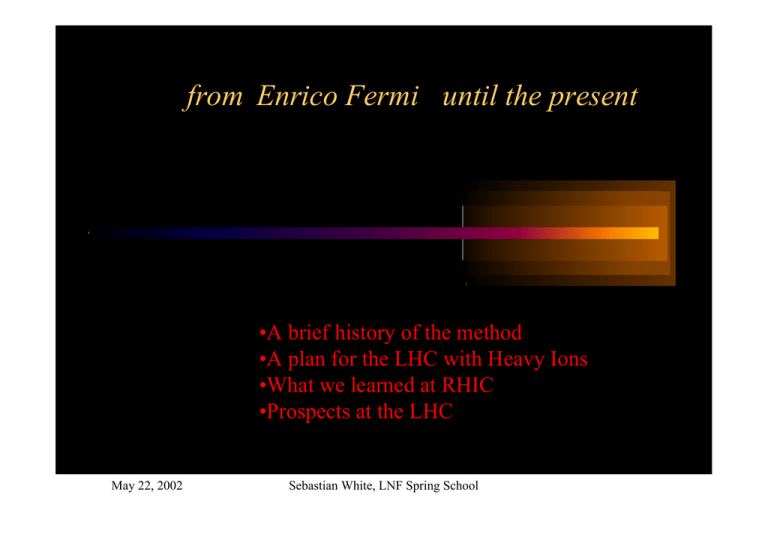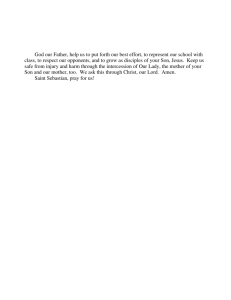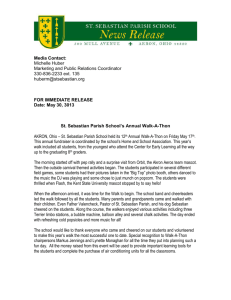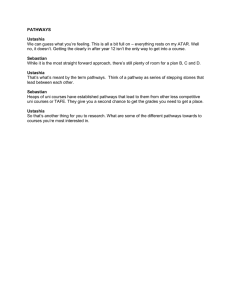Document
advertisement

from Enrico Fermi until the present
•A brief history of the method
•A plan for the LHC with Heavy Ions
•What we learned at RHIC
•Prospects at the LHC
May 22, 2002
Sebastian White, LNF Spring School
Some History
(γγ & γN Interactions
From Heavy Ions)
hep-th/0205086(9-May-02)
May 22, 2002
Sebastian White, LNF Spring School
Equivalent Photon
Approximation(Fermi,1924)
Electric Field due
to charged particle
May 22, 2002
Et may be decomposed via
Fourier Transform.Interactions
are those of equivalent (real) γ
spectrum
Sebastian White, LNF Spring School
Fermi calculated interations of non-relativistic e- and ions(α)
with Hg vapor and He (data of Sponer et al.). He used EPA
to derive interactions from calculated quasi-real γ flux and known
γ-Atom cross-sections.
In ~1933 Williams visited Copenhagen and discussed using EPA to
calculate e+(e-) production from cosmic ray interactions with matter.
Bohr encouraged von Weizsacker to work on this problem also.
In their papers W-W extended Fermi’s work to the Ultra-Relativistic
case and discussed limits of applicability of the method.
See. E.J.Williams:Proc.Roy.Soc. A139 163(1933), Phys.Rev.
45,729(‘34)
C.F.von Weizsacker: Zeits.Phys. 88, 612 (‘34)
Further developments: P.Kessler, Nuovo Cim. 17 (1960) 809.
V.M.Baier, V.S.Fadin, V.A.Khoze, Nucl. Phys. B 65 (1973) 381.
I.F.Ginzburg, V.G.Serbo, Phys. Rev. D 49 (1994) 2623.
Also: G.Racah, Nuovo Cimento, 14, (1937)93.
May 22, 2002
Sebastian White, LNF Spring School
Discussion of applications in ie.J.D.Jackson”Classical
Electrodynamics”
The Equivalent Photon Approximation was also extended beyond
Equivalent γ flux from charged particles. For example:
1)“Equivalent electron Approximation”
See:G.Altarelli and G.Parisi, Nucl.Phys. B65 298 (1977)
Also:I.Ginzburg and V.Serbo, Phys.Rev. D49 2623(1994)
May 22, 2002
Sebastian White, LNF Spring School
and the “Equivalent W Approximation”- see S. Dawson in “the Higgs
Hunter’s Guide”
The Method is used to analyze bremsstrahlung in ee and hadron colliders
where macroscopic dimensions(ie the size of a particle bunch) affect the
Photon spectrum:
“MD effect”- Ginzburg and Serbo ….
Coherent Bremsstrahlung (Eγ<~few KeV)- I.Ginzburg et al. PRL 68 788
(1992)
There are many analogies to Strong interaction calculations.
The Method is also widely used in Nuclear Physics………..
May 22, 2002
Sebastian White, LNF Spring School
“Hard Diffraction” terminology
Define “flux” :
X
dσ
P
p
2
p
dxP dt
fP p ( xP , t ) =
σ (Pp → X )
See ie Ingelman &Bruni, Phys. Lett. B 311(‘93)317
diffractive W/Z production.
_
^
dσ
∝ fP/ p (xP,t) • fq/ P(x1) • fq/ p (x2) •σ (qq →W / Z)
dxPdtdx1dx2
May 22, 2002
Sebastian White, LNF Spring School
Some highlights of discussion on Ultra-Peripheral at LHC
S.White (20 mins)
{mac}
A.J.Baltz(15 mins)
{plastic}
F.Meissner(20 mins)
{pc- yuk!}
May 22, 2002
Sebastian White, LNF Spring School
Report on the UPC Workshop at CERN(Mar’02)
S.White (20 mins)
{mac}
A.J.Baltz(15 mins)
{plastic}
F.Meissner(20 mins)
{pc- yuk!}
May 22, 2002
Sebastian White, LNF Spring School
CERN Heavy Ion Fora “UPC workshop”, “Hard Probes Workshop”
Heavy Ion Physics= Opportunities with a tool that we are just learning
to exploit (c.f. e+e- physics)
May 22, 2002
Sebastian White, LNF Spring School
Heavy Ion Physics ca. 2007 ?
May 22, 2002
Sebastian White, LNF Spring School
Heavy Ion Physics ca. 2007
The photon spectrum:
(slide from Stan Brodsky
On more rigorous
treatment of EPA)
May 22, 2002
Sebastian White, LNF Spring School
RHIC and LHC as high Luminosity γ-Hadron colliders
γbeamRhic=100
S=2mAω’
=>Nucleus at rest,effective lorentz γeff=2*γbeam2-1
Heavy Ions
e-Hadron collider
2
ω
α
1 dN( ) 2 Z 0.681hcγeff
=
ln(
)
π
Rnucleus•ω
2 dω
May 22, 2002
dN(ω) 2α me •γeff
)
= ln(
dω
ω
π
Sebastian White, LNF Spring School
May 22, 2002
Sebastian White, LNF Spring School
Does
+
0
A+p->A+n+W +H
s = 2 • m p • Eγ
E
Max
γ
≅ 200 − 300TeV
if : MW + M H 0 ≅ 200GeV
..............
May 22, 2002
Sebastian White, LNF Spring School
go?
Q:Why not use p-p since higher Luminosity*Running time?
A: Z2(or Z4) beats A0.3 *B0.3
Pb-Pb
p-p
“Pomeron”
γ−γ
May 22, 2002
Sebastian White, LNF Spring School
Kinematics and Analogy with Hadronic Diffraction
May 22, 2002
Sebastian White, LNF Spring School
May 22, 2002
Sebastian White, LNF Spring School
ZDC opportunity to trigger on
peripheral events
Au
γ
ρ0
P
Au
•Factorizes as function of impact parameter
•Estimates:
•Given a ρ0
ρ0 ~ 0.1%
•
Au
Au*+n
May 22, 2002
γ
Au*+n
ρ0 γ
P
Sebastian White, LNF Spring School
Au
Is the Pomeron like Equivalent Photon Approximation?
1960’s,70’s
(Ingleman-Schlein..)
− eiπα P ( 0 )
γ
Today
ρ,ω,φ…
p
May 22, 2002
Sebastian White, LNF Spring School
p
Large σ Processes at RHIC
Photodissociation
Pair production &capture
May 22, 2002
Sebastian White, LNF Spring School
+ AuAu->AuAu+e
e 33 kbarns
γ−γ
->AuAu+2(e+e-)
680 barns
->AuAu+3(e+e-)
50 barns
-
+
->AuAu+e
95 barns
b
L(γ-N)=1029 cm-2s-1 2<Eγ<300GeV
(At nominal RHIC running)
γ−Ν
AuAu->Au+Au*
92 barns
X+neutrons
AuAu->Au*+Au*
3.6 barns
X+neutrons
Y+neutrons
May 22, 2002
Sebastian White, LNF Spring School
May 22, 2002
Sebastian White, LNF Spring School
Correlated Mutual Coulomb Diss
Single:
Correlated:
σ
∞
2π ∫ [P(b)]2 bdb
σ (1)
cd =
b0
2α 2 Z 4
= 3 4
π γ
∞
∫ bdb[ ∫ ω dωσ ph (ω )K12(
b0
bω 2
)]
γ
102
May 22, 2002
Sebastian White, LNF Spring School
Eγ(MeV)
106
Low Energy Photonuclear
Cross sections and
n-multiplicities,momenta
(Saclay & Livermore data)
May 22, 2002
Sebastian White, LNF Spring School
Interaction Region Geometry
Zero Degree Calorimeter Acceptance
May 22, 2002
Sebastian White, LNF Spring School
Fiber response vs. angle
Θ,deg
e,µ
beam
ZDC Calorimeter construction:
•Tungsten absorber/ fiber (C)sampling
•2 Lint/module, 3 modules total
•C sampling filters shower secondaries
•Uniform response vs. impact point
May 22, 2002
Sebastian White, LNF Spring School
θ
Luminosity
and Beam
Quality
May 22, 2002
Sebastian White, LNF Spring School
ZDC measurement of Luminosity profile:zint
Interaction point(z)
May 22, 2002
ZDC resolution ~2 cm (σt~120 ps)
Sebastian White, LNF Spring School
Van der Meer scans
Using different interaction
triggers
May 22, 2002
Sebastian White, LNF Spring School
May 22, 2002
Sebastian White, LNF Spring School
Efficiencies(hadronic):
εbbc= (92 ± 2)% (HIJING)*
εbbc = (93 ± 2)% (JAM )
εzdc = (98 ± 2)% (conservative),
εzdc = (99.5 - 1.5)% (realistic)
*(in PHENIX Multiplicity PRL)
BBC ineff-> Coulomb bkg
Other corrections
•Coulomb-> BBC hits
•Coulomb->ZDC miss
•Diffraction Dissociation
(all negligible)
May 22, 2002
Sebastian White, LNF Spring School
Left ZDC neutron multiplicity
cut on 1n in Right ZDC
2n/1n cross sections, compared
To low energy radiochemical data
May 22, 2002
Sebastian White, LNF Spring School
*
*Definitions
σtot=σ(Mutual Coulomb Dissociation)+σ(geom)==σ(hadronic)
May 22, 2002
Sebastian White, LNF Spring School
Technology for tagging
Photonuclear processes
(and Pomeron mediated..)
E asymmetry=(EZDCl-EZDCr)/(E+E)
May 22, 2002
Sebastian White, LNF Spring School
Absorber and Beam Instrumentation (common design for
CMS and ATLAS I.r.’s)-TAN
+detectors
May 22, 2002
Sebastian White, LNF Spring School
May 22, 2002
Sebastian White, LNF Spring School
May 22, 2002
Sebastian White, LNF Spring School
May 22, 2002
Sebastian White, LNF Spring School
May 22, 2002
Sebastian White, LNF Spring School
May 22, 2002
Sebastian White, LNF Spring School
May 22, 2002
Sebastian White, LNF Spring School
May 22, 2002
Sebastian White, LNF Spring School
May 22, 2002
Sebastian White, LNF Spring School
May 22, 2002
Sebastian White, LNF Spring School
QuickTime™ and a
Video decompressor
are needed to see this picture.
May 22, 2002
Sebastian White, LNF Spring School
Conclusion
“The Best is yet to Come”
May 22, 2002
Sebastian White, LNF Spring School
May 22, 2002
Sebastian White, LNF Spring School
May 22, 2002
Sebastian White, LNF Spring School
Zero Degree Calorimetry:
Effective Shower Size Scintillator vs. ZCAl
Contaiment ≡ Signal ( r < R ) / Total
R
Beam In
May 22, 2002
Sebastian White, LNF Spring School
Testbeam Measurements (100 GeV p)
Response uniformity
May 22, 2002
Directional response
Sebastian White, LNF Spring School
May 22, 2002
Sebastian White, LNF Spring School




